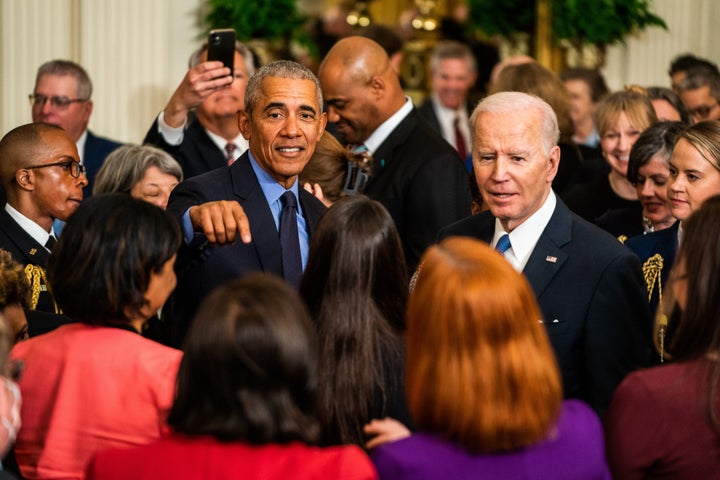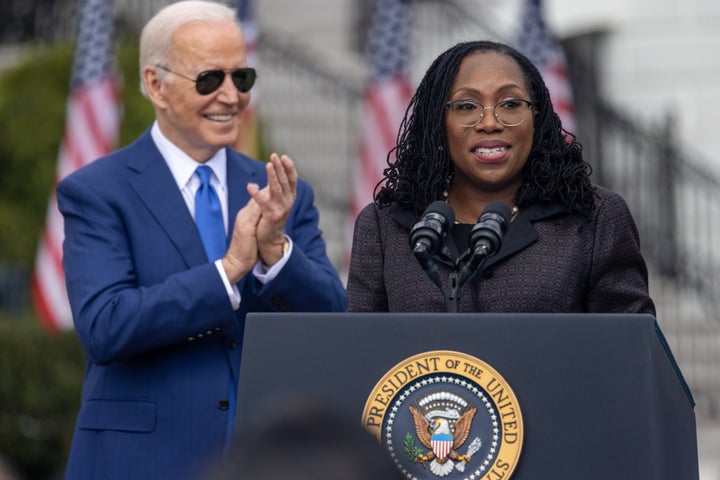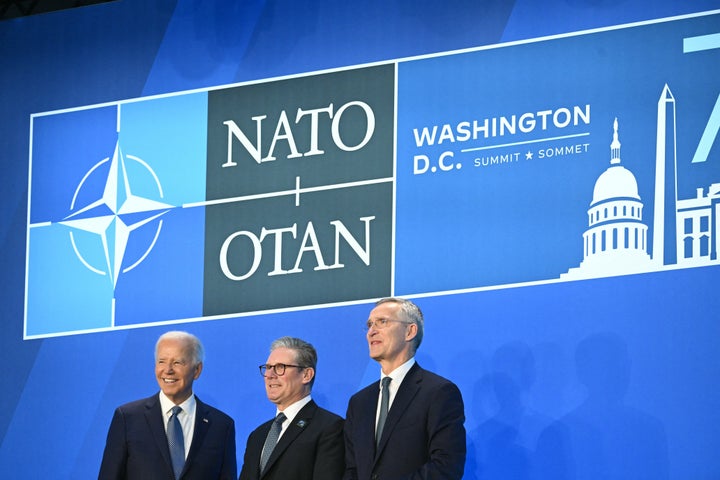Millions of new jobs, many in a flourishing new American manufacturing sector geared toward clean energy.
Higher prices at the grocery store, but also more dollars in paychecks.
A record low in the number of Americans without health insurance, plus a historic — if fleeting — reduction in child poverty.
Stronger international alliances, amid a bloody invasion of Ukraine and civilian catastrophe in the Middle East.
These are among the major developments tied to policy initiatives of Joe Biden’s presidency — which, because of his decision not to seek reelection, will end one way or another by Jan. 20, 2025. By any reasonable standard, they add up to a tenure of enormous consequence.
In less than four years, policy choices from the Biden administration have changed literally millions of lives in the U.S. and around the world, and maybe altered the course of climate change as well. It’s no exaggeration to say his record rivals that of any first-term president in the last half-century.
Still, it’s early to render definitive judgments on his policy legacy. Too much depends on seeing how his initiatives and decisions play out over time, what precise effects they have and, most immediately, whether his accomplishments even outlast his time in the White House.
If Donald Trump ends up winning in November, he’ll surely have something to say about that.
A Signature Piece Of Legislation
Biden’s signature achievement is the Inflation Reduction Act, the sweeping legislation that passed Congress on a party-line vote and that the president signed in August 2022. The name is misleading: Its central component is a massive federal investment in clean energy that, projections suggest, could add up to more than $1 trillion by the time all the money is accounted for.
Together with a series of regulations that effectively reduce incentives to create carbon emissions, the law’s investments have spurred a boom in factory-building and manufacturing. The proof of the impact is in the solar arrays and wind turbines popping up all across the Southwest and the Great Plains, along with the electric vehicle plants rising in the Midwest and across a new “Battery Belt” in the South. These projects mean employment, and represent a significant chunk of the estimated 15 million jobs that the U.S. has created during Biden’s presidency.
MANDEL NGAN via Getty Images
The other big piece of the Inflation Reduction Act — and one that, in spirit, hews closer to the name of the legislation — is a series of measures designed to reduce the price of health care, including pharmaceuticals.
The Inflation Reduction Act allows the federal government to negotiate directly with manufacturers, imposes penalties for rapid price hikes, and imposes a $35 cap on insulin for seniors and people with disabilities. Most of the provisions affect only Medicare, and even then only some drugs. But the law gives the federal government authority that counterparts abroad have long had, and that U.S. lawmakers in the future can expand.
Yet another Inflation Reduction Act provision offers extra financial assistance for individuals buying insurance through the Affordable Care Act, aka Obamacare. These new subsidies can reduce the cost of insurance by hundreds or even thousands of dollars a year. They are a big reason the proportion of Americans without insurance fell to 7.7%, the lowest level ever.
Action On Health Care, The Economy
The other factor in bringing down the number of uninsured people was a temporary, pandemic-related prohibition on states reviewing and disenrolling people from Medicaid. That prohibition has ended, which means the uninsured rate is likely to creep up in the next year or two.
The poverty level among children has already come back up, following a record-setting decline that was tied to yet another pandemic measure — namely, a set of tax breaks and direct cash payments in the American Rescue Plan, a Democratic bill that Biden signed shortly after taking office.
Biden and Democratic leaders had hoped to make some of those relief measures permanent. Their efforts to round up the votes fell just short. But the American Rescue Plan did what it was supposed to do: It buoyed the economy and sustained tens of millions of American households, at a time when COVID-19 and the reaction to it threatened to plunge the nation into a full-blown depression.

Demetrius Freeman/The Washington Post via Getty Images
All policies have trade-offs, of course. The massive public expenditures behind those relief efforts likely contributed to inflation, which peaked at 9.1% in 2022. People felt it viscerally when they bought food or clothing, put gas in their car, or tried to buy a house. But inflation was a worldwide phenomenon, tied to supply chain problems and other pandemic-related factors.
Inflation has since come back down, at least in the U.S., while wages are up and unemployment is hovering near 50-year lows. Analysts and leaders abroad have noticed, even if American voters haven’t, and editors at The Economist have been marveling at “America’s astonishing economic record.”
Building an economy that can continue to thrive in the future has been a big focus of Biden’s, and led to the enactment of two other major laws: the Bipartisan Infrastructure Law, which allocated more than $850 billion for everything from laying broadband lines to repairing dilapidated bridges, and the CHIPS and Science Act, which put nearly $300 billion into high-tech research and development. Both passed Congress with significant Republican votes, remarkable in itself given the polarization in U.S. politics.
Issuing Regulations, Appointing Judges
Biden didn’t achieve any of this alone. He worked closely with congressional leaders, as presidents always do. He also had the benefit of a (mostly) united Democratic caucus that, though smaller in size than its Obama-era counterpart, had a more liberal orientation with far fewer conservative dissenters.
The dissenters still mattered, enough to kill what Biden had hoped would be another major achievement: historic investment in the care economy intended to raise wages of child care workers and home health aides, while making it easier for families to pay for those services.
An attempt to pass bipartisan immigration reforms failed as well, leaving the Biden administration without the tools to address a surge in border crossings that has put a major and ongoing strain on city and state governments responsible for the migrants.
But throughout his presidency, Biden used regulatory power to make incremental progress on long-sought goals he couldn’t achieve through legislation — by hiking the minimum wage for federal workers, for example, or forgiving college debt for targeted populations.

Nathan Posner/Anadolu via Getty Images
Regulatory changes are easier than laws for subsequent administrations to reverse, and they can run into successful legal challenges. That’s especially true when lower courts heavily populated with Trump-appointed judges are applying principles handed down from a conservative Supreme Court majority hell-bent on scaling back federal regulatory authority.
But Biden has done what he could to provide some ideological balance by putting more than 200 judges on the federal bench, more or less matching Trump’s rate for the same time span. That includes the appointment of Justice Ketanji Brown Jackson, who in 2022 became the first Black woman to serve on the Supreme Court.
Jackson is just 53 years old, which means she can keep writing opinions defending causes like reproductive rights for decades to come. And although today she’s stuck putting most of those arguments into dissents with her two fellow liberal justices, she might be around long enough to see the court’s majority evolve or change, so that it retreats from its decadeslong march to the right.
Alliances, Wars And Diplomacy
The other area where presidents have more authority to act on their own is foreign policy. And there, Biden has left some especially clear marks, though frequently in ways that were — and remain — controversial.
He pulled American forces out of Afghanistan for good, a goal his predecessors and (according to polls) the public supported, and evacuated some 70,000 Afghan allies in the process. But 13 U.S. service members and dozens of civilians died in a bombing during the chaotic withdrawal, which ultimately left behind tens of thousands of Afghan allies hoping to escape — and left the Taliban once again in charge of the country.
More recently, Biden has strongly backed Israel ever since Hamas militants attacked the country and massacred civilians on Oct. 7, 2023. Biden has pushed back only tepidly — and, by most accounts, ineffectively — against an Israeli response that has literally flattened much of Gaza, killing tens of thousands of people and leaving many more in dire, life-threatening humanitarian conditions.

SAUL LOEB via Getty Images
In both instances, it’s hard to know exactly what has happened, or what could have happened in alternative scenarios, given the factual ambiguities of armed conflict and the secretive nature of diplomacy. Biden’s handiwork and its impact are clearer when it comes to NATO, which, appropriately enough, held its 75th anniversary summit in Washington just a few weeks ago.
Biden led efforts to expand the alliance with the addition of Finland and Sweden, and to strengthen it by drawing larger financial and troop contributions from member states. In 2022, Biden organized international backing for Ukraine following Russia’s invasion, providing diplomatic, financial and military support that are still propping up the country today.
The Legacy At Stake In November
America’s support of Ukraine could be one of the first things to go in a second Trump presidency. Trump, whose affinity for Russian President Vladimir Putin is no secret, has pledged to demand a cessation of hostilities under terms most analysts think would be highly favorable to the Russians. Sen. JD Vance (R-Ohio), who is now Trump’s running mate, has led calls in Congress for stopping Ukraine aid.
But the list of Biden accomplishments that Trump could reverse doesn’t stop there.
Trump has said he wants to take away the big push for clean energy, vowing to end what he calls the “electric vehicle mandate” on “day one.” He has said he still wants to repeal the Affordable Care Act, just like he tried so desperately to do in 2017, posting on his Truth Social platform that “Obamacare sucks!” and promising the same mythical replacement he always touts but never specifies. Even if Trump decides against another run at full repeal, he seems unlikely to support renewal of Biden’s extra insurance subsidies, the funding for which runs out in 2025.
It’s difficult to be certain exactly which of these priorities Trump might pursue or when, because he doesn’t make concrete policy commitments or issue detailed policy papers in the traditional way. But credible guides to his behavior are out there.
In addition to documents like Project 2025, the right-wing governing agenda his current and former aides have put together, there’s the historical record from his last turn in office, when he signed legislation reopening the Arctic wildlife lands for drilling, undid new civil rights protections for the LGBTQ+ community, and reversed countless immigration directives.
Biden on the campaign trail warned about the threat to his administration’s accomplishments, lamenting that all of his new laws and regulations — and their effects on daily life — haven’t gotten the attention they deserve. He had a point. Awareness of his accomplishments is so low that Republican lawmakers frequently felt comfortable taking credit for benefits in their districts or states, even when they had voted against them in Congress.
History’s verdict is likely to be more accurate and more laudatory, because with time, it will be easier to take the full measure of what Biden has really done. But a lot depends on how many of his achievements survive. That’s why the best thing Biden may have done for his legacy is giving another, more capable Democrat a fighting chance to protect it.
